Lung cancer other diagnostic studies: Difference between revisions
Jump to navigation
Jump to search
No edit summary |
|||
| Line 22: | Line 22: | ||
|- | |- | ||
|[[Image:IJRI-25-109-g009.jpg|thumb|300px|FDG PET in nodal disease false-positive study. Maximum intensity projection (MIP) image shows an FDG-avid primary lung tumor on the right side (arrow, A) and multiple foci of FDG uptake in the mediastinum (arrowhead, A). CT scan shows enhancing, primary tumor (arrow, B). Fused PET/CT image shows FDG concentration in the mediastinal nodes, suggesting metastatic involvement. Mediastinoscopy and biospy revealed tuberculosis,via <https://www.ncbi.nlm.nih.gov/pmc/articles/PMC4419420/figure/F9/>This is an open-access article distributed under the terms of the Creative Commons Attribution-Noncommercial-Share Alike 3.0 Unported, which permits unrestricted use, distribution, and reproduction in any medium, provided the original work is properly cited.<ref name="PurandareRangarajan2015">{{cite journal|last1=Purandare|first1=NilenduC|last2=Rangarajan|first2=Venkatesh|title=Imaging of lung cancer: Implications on staging and management|journal=Indian Journal of Radiology and Imaging|volume=25|issue=2|year=2015|pages=109|issn=0971-3026|doi=10.4103/0971-3026.155831}}</ref>]] | |[[Image:IJRI-25-109-g009.jpg|thumb|300px|FDG PET in nodal disease false-positive study. Maximum intensity projection (MIP) image shows an FDG-avid primary lung tumor on the right side (arrow, A) and multiple foci of FDG uptake in the mediastinum (arrowhead, A). CT scan shows enhancing, primary tumor (arrow, B). Fused PET/CT image shows FDG concentration in the mediastinal nodes, suggesting metastatic involvement. Mediastinoscopy and biospy revealed tuberculosis,via <https://www.ncbi.nlm.nih.gov/pmc/articles/PMC4419420/figure/F9/>This is an open-access article distributed under the terms of the Creative Commons Attribution-Noncommercial-Share Alike 3.0 Unported, which permits unrestricted use, distribution, and reproduction in any medium, provided the original work is properly cited.<ref name="PurandareRangarajan2015">{{cite journal|last1=Purandare|first1=NilenduC|last2=Rangarajan|first2=Venkatesh|title=Imaging of lung cancer: Implications on staging and management|journal=Indian Journal of Radiology and Imaging|volume=25|issue=2|year=2015|pages=109|issn=0971-3026|doi=10.4103/0971-3026.155831}}</ref>]] | ||
| | ||[[Image:IJRI-25-109-g014.jpg|thumb|300px|Pleural effusion and role of FDG PET/CT. Enhancing lung masses seen on CT scans in two different patients (arrows in A and C) with minimal pleural effusions (arrowheads in A and C). Corresponding PET/CT scans show intense FDG-avid metastatic pleural deposits (arrowheads in B and D) as the cause of effusions. Note that the pleural deposits are barely perceptible on CT, via<https://www.ncbi.nlm.nih.gov/pmc/articles/PMC4419420/figure/F14/>This is an open-access article distributed under the terms of the Creative Commons Attribution-Noncommercial-Share Alike 3.0 Unported, which permits unrestricted use, distribution, and reproduction in any medium, provided the original work is properly cited.<ref name="PurandareRangarajan20152">{{cite journal|last1=Purandare|first1=NilenduC|last2=Rangarajan|first2=Venkatesh|title=Imaging of lung cancer: Implications on staging and management|journal=Indian Journal of Radiology and Imaging|volume=25|issue=2|year=2015|pages=109|issn=0971-3026|doi=10.4103/0971-3026.155831}}</ref>|link=https://www.wikidoc.org/index.php/File:IJRI-25-109-g011.jpg]] | ||
|- | |- | ||
| | | | ||
Revision as of 16:44, 16 February 2018
|
Lung cancer Microchapters |
|
Diagnosis |
|---|
|
Treatment |
|
Case Studies |
|
Lung cancer other diagnostic studies On the Web |
|
American Roentgen Ray Society Images of Lung cancer other diagnostic studies |
|
Risk calculators and risk factors for Lung cancer other diagnostic studies |
Editor-In-Chief: C. Michael Gibson, M.S., M.D. [1] Associate Editor(s)-in-Chief: Dildar Hussain, MBBS [2]
Overview
Other diagnostic studies include bone scintigraphy, PET scan, and molecular tests.
Lung Cancer Other Diagnostic Studies
Bone Scintigraphy
A bone scan may demonstrate bone metastases.
PET scan
- FDG(18 F fluoro deoxyglucose) PET scans along with contrast enhanced CT may be helpful in the diagnosis of extent of lung cancer. Findings on FDGPET/CT suggestive of lung cancer include:[1]
- Solitary pulmonary nodule
- Benefits of FDGPET/CT include:[2]
- Accurate delineation of the viable tumor from surrounding atelectasis and collapse or consolidation.
- It may further lead to a change in staging of the lung cancer.
- Provide guidance for the biopsy.[3]
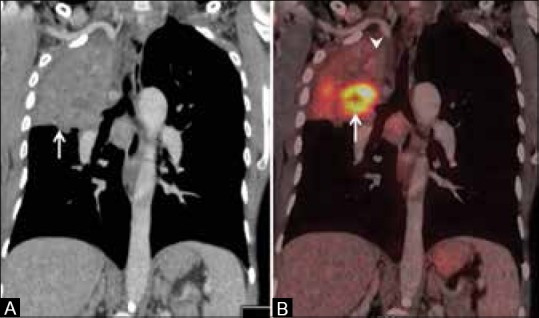 |
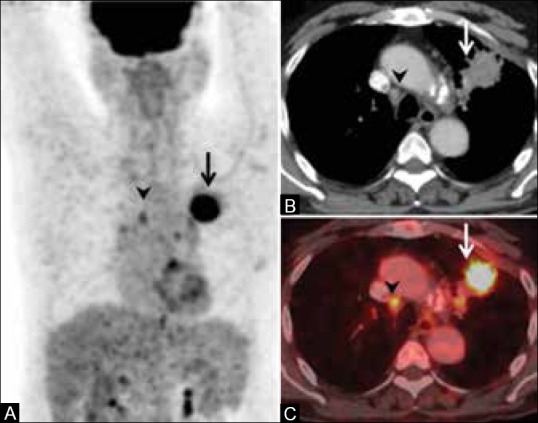 |
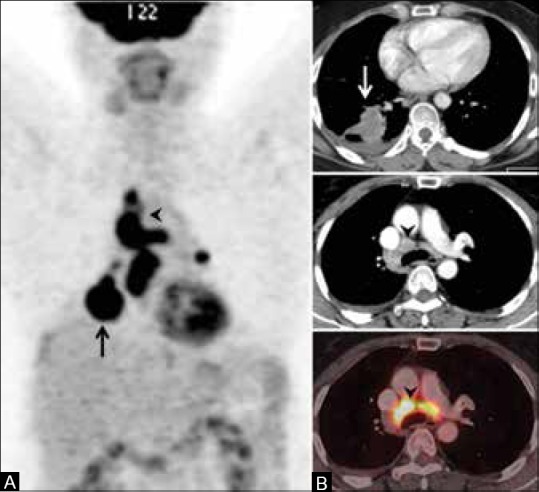 |
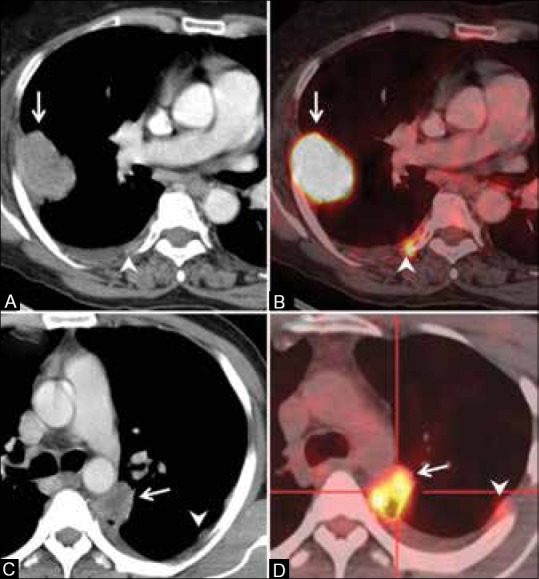 |
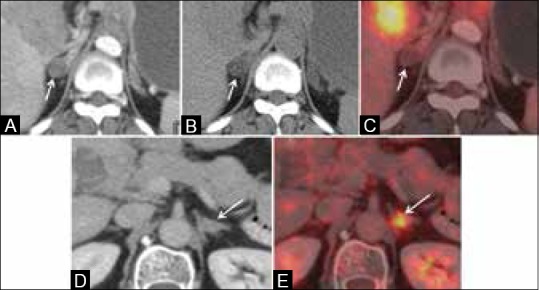 |
Molecular Test
Molecular tests include epidermal growth factor receptor (EGFR) mutation and anaplastic lymphoma kinase (ALK) mutation. Specific targeted agents may be administered to patients if these mutations are present.
References
- ↑ 1.0 1.1 1.2 1.3 Purandare, NilenduC; Rangarajan, Venkatesh (2015). "Imaging of lung cancer: Implications on staging and management". Indian Journal of Radiology and Imaging. 25 (2): 109. doi:10.4103/0971-3026.155831. ISSN 0971-3026.
- ↑ van Baardwijk, Angela; Baumert, Brigitta G.; Bosmans, Geert; van Kroonenburgh, Marinus; Stroobants, Sigrid; Gregoire, Vincent; Lambin, Philippe; De Ruysscher, Dirk (2006). "The current status of FDG–PET in tumour volume definition in radiotherapy treatment planning". Cancer Treatment Reviews. 32 (4): 245–260. doi:10.1016/j.ctrv.2006.02.002. ISSN 0305-7372.
- ↑ Purandare, Nilendu C.; Kulkarni, Aniruddha V.; Kulkarni, Suyash S.; Roy, Diptiman; Agrawal, Archi; Shah, Sneha; Rangarajan, Venkatesh (2013). "18F-FDG PET/CT-directed biopsy". Nuclear Medicine Communications. 34 (3): 203–210. doi:10.1097/MNM.0b013e32835c5a57. ISSN 0143-3636.
- ↑ 4.0 4.1 Purandare, NilenduC; Rangarajan, Venkatesh (2015). "Imaging of lung cancer: Implications on staging and management". Indian Journal of Radiology and Imaging. 25 (2): 109. doi:10.4103/0971-3026.155831. ISSN 0971-3026.